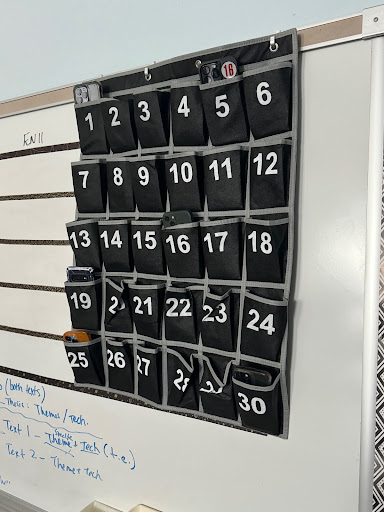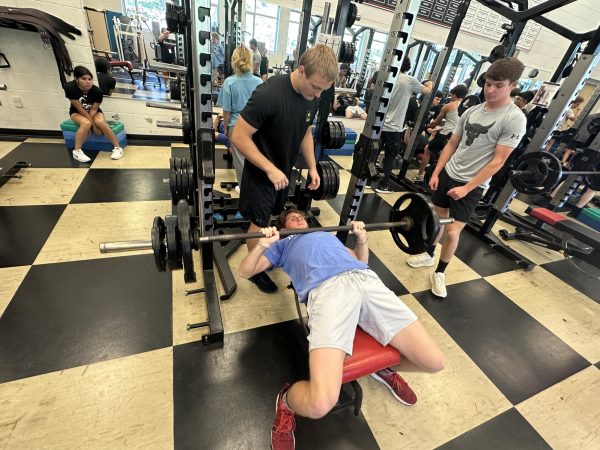Unpopular Opinion: We need more drills
On the left is how organized fire drills should be. On the right is how unorganized fire drills are when they aren’t practiced.
Update: I want to give a huge thank you to the senior class for repainting the classroom numbers outside. This will help students so much more during future drills!
On February 22, during the first fire drill of Semester 2, students were wandering around the parking lot looking for their teachers, a little like an Easter Egg hunt. That’s why we need more fire drills.
Now I know everyone hates fire drills–teachers and students.
But let’s talk about a real emergency.
“We try to schedule drills randomly because we don’t want to prepare anyone for them. Doing this helps students know what to do during a real emergency,” said Michelle Gilmore, Assistant Principal. One of Gilmore’s responsibilities is planning and executing emergency drills.
Plenty of the required drills took place in September and October. Then cold weather hits, and drills stall, too. LHS needs to begin having fire drills more often, not just every few months. As the last drill shows, students are unsure where they are supposed to go. Teachers in each class could prepare students better for the eventual drill (or real emergency).
“If I could change anything about drills, it would be spending a day in each period going over where to go and what to do during an emergency situation,” said Class of 2025 member Rachel Beckman.
During the drill, each teacher uses their red emergency binder to hold up signs with their name in bold and call roll. With the first drill of the semester so close to the change of semester, teachers were caught off guard and many didn’t have their name cards, binder, or attendance with them.
Another problem is that no one seems to know where to stand. Front or back of school? Which curb? Teachers expect their students to find them and get in line. How can students be expected to do so if their classroom numbers are faded along the curb and they don’t review in advance?
New teachers in the building will not know where to go either if a review of each location isn’t established. A possible faculty meeting in the spring could include walking outside and determining locations for all teachers.
Many teachers have a “fire drill partner,” someone who can help if a teacher is absent.
“I know in the past there have been markers for where classrooms are supposed to stand and they were painted on the sidewalk. I think repainting those, possibly having the senior class take that on as a project, and just have clear lines where each of the teachers and students are supposed to go is definitely a way to make our fire drills better,” said Joseph Athey, math teacher.
The classroom numbers were painted on the curb outside by the senior class a long time ago, but they have faded to a point where they’re close to illegible. This is an easy fix, and the senior class has a plan.

“The senior class has repainting the curbs on their spring list of things to do for service projects,” said Jeremy Brown, Senior Class and SGA Advisor.
Proper instruction and drills often will help reduce confusion, panic, and any disorderly behavior.
Of course, a drill and a real emergency are very different.
“I think fire drills are pointless. Nobody is going to calmly walk away from an actual fire,” said Class of 2025 member Ayden Taylor.
Most think that school fires rarely happen and practicing for something that will mostly not happen isn’t worth it. According to the National Fire Protection Association, “In 2014–2018, U.S. fire departments responded to an estimated average of 3,230 structure fires in schools each year.” That’s more than you might think, isn’t it?
“Students could improve by making sure that they are with their teacher during all fire drills,” said Gilmore.
It’s not a time to wander and visit friends. In defense of the students, though, with everyone exiting the building in one or two common stairwells, it’s easy to “lose” a teacher and classmates.
All school staff need to help students evacuate the school during an emergency. With the amount of students and panic involved, this can be difficult. If everyone has enough experience with evacuating properly during a drill and knowing where to go, it will be much easier to get outside safely with no one getting hurt.
Practicing builds confidence in staff and students that they are prepared for an emergency situation. Emergency response procedures are skills important to master.
The problem isn’t only fire drills but also every other emergency drill. The best way to prepare for an emergency is to create a way of communication to disperse information as quickly as possible. LHS is always sure of this when announcing over the PA system before drills are about to begin. Even though communication is made, that doesn’t mean every student completely understands what they are expected to do.
In December 2021, LHS had a possible emergency situation, and it escalated quickly. There was a threat on social media that caused the school to go into a temporary lockdown.
“I would say that I was unprepared for the situation because the administration didn’t tell us anything that was going on. All they told us was that the rumors going around weren’t credible, — Class of 2025 member Makyla DeVries
Real emergencies don’t always have a clear plan. The administration has to work with students, staff, and emergency personnel. Events unfold quickly.
Some students who had experience from previous drills went through procedures that they knew, before teachers even knew what was going on. They covered windows, closed doors to make sure they were locked, and moved to windowless parts of the classrooms.
However, if we were to have more drills similar to what we could have gone through, everyone would have been much more calm and felt more safe. Yet, that wasn’t the case. This type of situation is something we don’t often prepare for. Students, parents, and staff were confused and didn’t know what should happen.
“Before the lockdown happened, I saw a bunch of rumors on social media. I was really confused and scared because it was sudden and I saw some girls in my class crying about it. After a few minutes of no responses from the staff, I just thought it was one big rumor even though we were stuck in our classroom for a straight 15 minutes,” said Class of 2025 member Skylar Shields.
Students were in a panic and turned to asking their teachers questions that they didn’t know how to answer.
“I think the staff handled the situation poorly, and we’ve never really learned what to do during this kind of situation. The teachers didn’t provide much information and this caused me to assume that our school was in more danger than it actually was,” said Shields. Teachers received very little information that day.
With more practice through all types of drills, even those that seem rare, will further prepare students and staff how to correctly react to an emergency situation.
Your donation will support the student journalists of Linganore High School. Your contribution will allow us to purchase camera/recording equipment and cover our annual website hosting costs. We hope to raise enough money to re-start a monthly printed issue of our paper.
















